(A Virtual Symposium)

When they reach puberty, youngsters start to feel sexual attraction to other people. Strong new feelings that they could not experience before now affect their life. The capability to experience those feelings has evolved in their brains during childhood. The following is the transcript of a symposium on this phenomenon that was moderated by professor Morie and was attended by four students from different majors: Becky, biology; Bob, criminology; Claire, education, and Sol computer science.
Contents
WELCOME
BACKGROUND
Similarities between brains and computers: APPs and OPPs
The two components of sexual orientation: attraction and arousal
"Pure Nature" sexual behavior
Pheromones as sexual arousal messengers
How much brain does it take to have sex? The example of c. Elegans
THE CHALLENGE
LEARNING SEXUAL AROUSAL IN CHILDHOOD
Imprinting
Innate emotions and automatic imprinting of new sexual arousal cues
Development of new concepts from old ones
States-of-mind and hormones
INNATE EMOTIONS AND SEXUAL AROUSAL
Feeling Safe And Threatened With Another Person (SAT-WAP)
Sexual SAT-WAP and social SAT-WAP
Courtship and sexual arousal in other species
The emotional components of human sexual arousal
Mental processes in BDSM
Intimacy and SAT-WAP
Arousal fantasies in children and adults
SAT-WAP and physical stimulation
WELCOME
Morie
Welcome to the symposium “Development of Sexuality in Childhood”. Sexuality is a major component of our personality. Although we know a lot about its physical expressions, we know much less about the mental forces that drive it. In our childhood, we cannot express it. The first time that we can express our sexuality is when we reach puberty. After that it appears in a variety of individual expressions. In our discussions here we will try to uncover the mental processes that build human sexuality from birth to puberty. Which parts of it are already embedded in our brains when we are born, and which parts we acquire from our personal experiences. Please feel free to ask questions, and I encourage you to share with us your opinions. Raising questions and discussing opinions promote knowledge.
BACKGROUND
Similarities between brains and computers: APPs and OPPs
Morie
The brain controls our voluntary activities. Controlling even the simplest activities is a complex data handling operation. It involves processing input data from millions of sensory cells and coordinating the activities of numerous motor units. The fact that the brain operates consistently, time-and-again, is an indication that it uses what may be called operation-programs (OPPs). Those opps reside in the brain’s memory.
Sol
That reminds me of computers that use APPs for performing complex tasks. The apps are stored in the computer’s memory.
Morie
That's right. Computers come with a set of basic programs that enable them to perform basic general tasks, and another set of basic programs that enable them to install and to use new apps. The new apps are specific to the tasks that each computer has to perform. Similarly, a newborn's brain has one set of opps that controls the basic life sustaining activities of the body, and another set of basic opps that enable the brain to develop and to use new opps, according to the specific environment in which the child happens to live.
Becky
I understand that the innate opps together with the acquired ones control our physical activities, as well as our conscious and sub-conscious mental activities.
Morie
Pretty much so. Computer apps are organized in hierarchies in which complex apps use simpler ones, which eventually use a small set of basic operations. The apps operate on variables, which are also organized in hierarchies. For example, a spellchecker's app directly operates on words and letters. The letters are encoded by zeros and ones. The basic general operations of the computer operate on those zeros and ones. Similarly, the brain opps are organized in hierarchies that use a small set of basic brain operations. The opps operate on concepts, which are also organized in hierarchies. For example, the opps by which we recognize faces operate on concepts, such as eyes, nose, and mouth. Those concepts are evoked by basic stimuli that come from light sensing cells in our eyes.
Becky
How does the brain learn new opps and new concepts, and then uses them? Understanding that would help us understand how consciousness and sub-consciousness build our mind.
Morie
I agree. In our meeting, I would like to talk about the opps that control the mental aspects of sexual behavior, and how they evolve; how, using innate opps and concepts, a child’s brain processes daily experiences, and assembles the opps and the concepts that will control sexual activities at puberty. Those innate opps work sub-consciously. I would like to focus on the development of the mental aspects of the first two stages of any sexual activity: sexual attraction and sexual arousal.
Becky
Your starting point is that we are born with innate opps and concepts that guide the sub-conscious development of our sexuality. That means that some parts of our adult sexual behavior is already determined at birth - that there are parts of our sexuality that are beyond our control. Why not assume that a newborn’s brain is like a ‘blank-slate’, and our sexuality is determined completely by how we are treated as children and by what we are being told and taught?
Morie
That would be in contradiction to the nature of Mother Nature. There are rules according to which things happen in nature; rules that are common to all species. Since humans are part of nature, some rules and mechanisms that apply to other species also apply to humans, even if we cannot yet verify their details. This goes back all the way to DNA and genes. We share many of our genes with other species. It has been demonstrated that some of the shared genes cause similar effects in humans and in other animals.
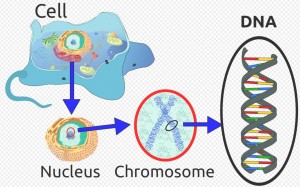
Sexual activities are critical for the survival of every species, and Mother Nature would not leave them out of her planning. In some species they are completely determined genetically, and in others they are combinations of nature and nurture. There is mounting evidence that also in humans the brain has innate opps that determine the main features of our sexual behavior. Those opps leave some leeway for adjustments to the physical and social surroundings. This will be the focus of our discussions.
Claire
Could we see examples of animals whose entire sexual behavior is hard-wired by their genes, and animals that learn some of their sexual behavior?
Morie
Sure. Observing sexual behavior of animals could give us hints about sexual opps and concepts that operate in our brains too. But let us first define the scope of our discussions.
The two components of sexual orientation: attraction and arousal
Morie
In the first phase of human sexual interaction, an originator chooses a partner based on the partner’s sex. During the second phase, other features of the partner and the activities of both participants create the feelings of sexual arousal. The two phases are distinct, but the line that separates them is blurry. Some features of the would-be partner, such as looks and clothing, affect both the selection and the arousal. In addition, the arousal is also affected by the physical and social circumstances in which the two parties happen to be at that time.
Claire
Our assignment seems really complicated. It is about opps that control the diversified sexual activities of straight men and women and of LGBT individuals. What would be our strategy for studying that multitude of behaviors?
Morie
We’ll divide the opps to two groups. The opps of the first group depend on the sexes of the partners, and those of the second group are sex-independent. The sex dependent opps are responsible for selecting a partner of the desired sex. The second group is responsible for the arousal of emotions that depend on sex-independent factors. Those emotion are common to all the participants, regardless of their sex. The two groups of opps operate at the same time and complement each other.
A newborn’s sex organs and the opps that control them are not yet developed. They develop during childhood and become operational at puberty. The opps that control sexual behavior do not require external intervention for their development. They evolve from non-sexual experiences of the child. The specific details of that development are intriguing, but, for obvious reasons, it is impossible to prod the brain in order to uncover them. We need to rely on circumstantial evidence in order to understand those processes.
Bob
I thought that science is based on real facts, not on circumstantial evidence.
Morie
Any scientific theory may rely on direct and on circumstantial evidence. The requirements are that the theory explains observable facts, does not contradict facts, could predict related events, and could be refuted by factual evidence.
Bob
Why do we limit our discussions to sexual orientation and arousal at puberty? Why is this age restriction?
Morie
The sexual behavior that emerges at puberty results from non-sexual experiences that were incorporated sub-consciously by innate learning mechanisms. After puberty, the pleasures of actual sexual experiences, in combination with social influences and conscious cognitive processes, affect the continued development of sexual behavior. It is easier to see the roles of nature and nurture at puberty than at the later stages in life. As you’ll see, there are several fascinating innate processes that happen during childhood and affect our sexual behavior at puberty and later-on in life.
There are many similarities between human and animal behavior. In our discussions we will highlight some of those similarities and try to draw from them conclusions about human behavior.
"Pure Nature" sexual behavior
Pheromones as sexual arousal messengers
Morie
Let us examine now some animal opps that direct sexual activities. In general, the sexual process requires the cooperation of two individuals. The process has many steps, and coordination between the activities of the partners is crucial for its successful completion. During the process, the individuals communicate about the stage in which they are found or that they have just completed. This communicated information enables each partner to coordinate its own activities with those of its mate. Visual, auditory, tactile and chemical cues may be used in the communication. The actual modes of communication depend on the species and on the particular stage of the sexual process. After a cue has been received by an individual, it is processed and eventually prompts a response.
Many animals use pheromones to convey to their partners the sexual stage in which they are found. The release of a specific pheromone by one individual and the grasping of its significance by the mating partner is one of many orchestrated processes that take part in each of the partners. Pheromone communication is genetic. Differences between the genes of the males and the females of a species account for the production and release of a pheromone by one of the sexes and its detection and incorporation by the other.
Bob
What is the difference between hormones and pheromones?
Morie
Pheromones are compounds generated and released by one organism, that when received by another organism of the same species, can cause in it behavioral or physiological changes. Hormones are compounds that are released by an organism into itself, and affect its own behavioral or physiological processes.
Claire
Would you say that pheromone communication is an example of a process that is “nature”, as opposed to “nurture”?
Morie
Yes, because the production and release of pheromones by one mate and their detection and implementation by the second mate have been linked in a number of species to specific genes.
Claire
Are there genetic opps of sexual processes in animals that involve pheromones in combination with other cues?
Morie
Yes. Virgin females of certain fruit flies are attracted to a pheromone released by males. Sensing that pheromone changes the “state-of-mind” of the female from foraging to reproduction. The female follows that pheromone, and prefers it to fruit scents that she encounters. Once next to a male, other chemical, visual and tactile stimuli are exchanged and guide the mating.
Luring potential mates by sex pheromones is not restricted to insects. Birds, fishes, reptiles and mammals, such as female dogs and lionesses in heat, spread pheromones to attract males from great distances.
Bob
Are pheromones involved in the human sexual process?
Morie
Receptors of sex pheromones have been identified in many species. The vomeronasal organ is an organ in which sensing and preliminary processing of pheromones take place. It is found in a variety of vertebrates, including reptiles and mammals, and it has been implicated in sexual and social behaviors. In humans, though, the vomeronasal organ develops between seven and twenty-five weeks of gestation, and then it regresses and disappears completely, turning into cartilage. As of now, no pheromone has been implicated as a necessary cue in human courtship or mating.
![By Appaloosa (Own work) [CC BY-SA 3.0 (http://creativecommons.org/licenses/by-sa/3.0)], via Wikimedia Commons flehmen lion](http://www.micropsychology.org/wp-content/uploads/2016/08/fehmen-lion-300x265.jpg)
![By Bernard DUPONT from FRANCE [CC BY-SA 2.0 (http://creativecommons.org/licenses/by-sa/2.0)], via Wikimedia Commons Flehmen African buffalo](http://www.micropsychology.org/wp-content/uploads/2016/08/Flehmen-African-buffalo-300x172.jpg)
How much brain does it take to have sex? The example of c. Elegans
Sol
We are going to talk a great deal about the relationships between brain, mind and body, especially in relation to sex. In some species, the entire sexual behavior is innate, and determined by the genes. In other species, sexual behavior is a combination of genetic and learned information. It both cases, everything is controlled by the brain. I was wondering, how much brain does it take to carry out the innate "nature" parts of sex?
Morie
A very valid question. In order to get some perspective on the relationships between brain and function in nature, let me tell you about an animal, the C. elegans. C. elegans (Caenorhabditis elegans), a member of the phylum Nematoda, is a one millimeter long worm; the size of a coma in a book. It lives in the soil and in rotting vegetation, feeding on microbes such as E-coli. Numerous research groups have been studying this little worm, and several of them were awarded the Nobel Prize in Physiology and Medicine for their discoveries. Due to its relatively short life span (2-3 weeks), C. elegans is amenable to genetic studies. Its genome is thirty times smaller than the human genome, but still, about 35% of its genes have DNA sequences similar to humans (homologs). Many of the C. elegans’ genes function like mammalian genes.
C. elegans has two sexes: male and hermaphrodite. It reproduces through male-hermaphrodite mating and by hermaphrodite self-insemination. The hermaphrodite has 959 cells, the male has slightly more; all are visible with a microscope. Out of those cells, about 300 are neurons, whose synapses have been mapped.
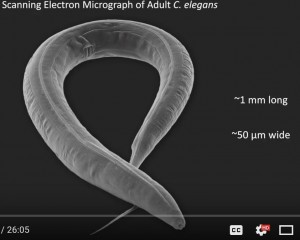
What are neurons and synapses?
Morie
Neurons are nerve cells. Neurons are connected to each other. Some neurons are connected also to motor units or to sensory units. A connection between two neurons or between a neuron and a motor unit is called a synapse.
Some of the C. elegans’ neurons form sensory structures that mediate responses to taste, smell, touch, temperature and light (it has no eyes, though). Other neurons form a central ring and two neural tracts, with connections to the sensory structures and to muscular units. These may be considered as the C. elagans' brain and nerve system. C. elegans has 81 muscle cells, a digestive system and a reproductive system.
The mating behavior of the male consists of a sequence of activities, which are coordinated by cues from his hermaphrodite counterpart. In mating, every male C. elegans executes the same exact activities. First, sensory units on his tail recognize her. He then aligns himself against her, crawls back on her until he reaches her end, and turns his body. His hook explores her and finds the vulva. In rhythmical up and down motion, his spicules tap the lips of her vulva until they respond and open up. His anal sphincter shuts off his anus and the spicules begin their penetration. Initially, uterine signals prevent the advancing spicules from transferring sperm. Only after they have reached the right position, a second uterine signal mediates ejaculation. The spicules remain inserted for another 25-30 seconds, while she rests motionless. After that, he deposits a plug in the uterus and retracts the spicules.
This opp is apparently hardwired in the C. elegans’ neural system. By studying mutant males, mutant genes that cause defects in specific steps of the mating process were identified. Correlations were found between mutant genes and defects in the animal’s responses to contact, backing, turning, locating the vulva, and inserting the spicules.
Overall, the opps of the male and the hermaphrodite consist of sequences of innate activities. Each activity has a trigger and a terminator. Cues to activities that require coordination between the mates are provided by the sexual partner. Those cues are chemical or mechanical. The order of the activities is maintained by units that act as a terminator to one activity and as a trigger to the following one. This design allows for skipping stages of the process, if a subsequent stage has already been triggered. For example, if the male happens to be near the vulva at the onset, the un-needed crawling back would not be triggered, and the mating process will go on with the hook sensing the vulva.
Sol
Amazing! Three hundred nerve cells can regulate all those operations, in addition to regulating all other activities such as moving and feeding. No computer can even come close to such performance!
Becky
And this primitive brain, billions times smaller than ours, controls all the physical sexual activities that are so similar to ours.
Claire
And the genome has precise control over the development of that system. It’s pure “nature”; no “nurture”.
Sol
Now, let's talk about humans. The C. elanags needs only a few nerve cells to control all its sexual activities. How many human brain cells does it take to control one's sexual activities?
Morie
I cannot give you a figure, but we should distinguish between two components of human sexual activities: the physical and the mental. The physical component involves the activities of the sex organs and the body parts that support them, such as muscles and glands. The mental component handles the selection of a mate, interactions with the mate, and arousal. My understanding is that many more brain cells are involved in the mental parts than in the physical part. However, most of the cells that are involved in the mental parts are involved also in controlling other mental activities, especially those related to the interactions of the individual with other people in the surrounding society.
THE CHALLENGE
Bob
So, unlike in the C. elagans, the sexual opps in humans depend on both nature and nurture. Which human opps are learned?
Morie
Learned elements that vary from person to person include identification of a potential mate (sexual attraction), becoming aroused by features of the selected mate, by own activities and by activities of the mate, and ways of arousing the mate. Parts of those elements may be learned through experiences that are not sexual in nature, even before puberty. There are elements that are learned through direct involvement in sexual activity, such as body positioning, coordination with the mate, and timing.
A main difference between the sexual behavior of C. elegans and that of humans is in the nature of the cues that the partners exchange in order to sustain the process. All the cues of the C. elegans are genetic: the genes build the body parts that synthesize and release the pheromone in one of the sexes and the parts that receive and identify it and then trigger the appropriate activity in the other sex. The entire process is genetic. In humans, on the other hand, some of the process is learned. In different geographical locations and in different historic times humans have been relying on different cues to be sexually attracted and aroused by each other. Those cues were learned by fundamental genetic learning mechanisms.
One of our challenges is to come up with gene-mediated learning mechanisms that are flexible and robust enough to guaranty the continuation of the human race. Those learning mechanisms should be able to pick up sexual attraction and arousal cues in any society and engrave them in the minds of children in those societies. At puberty, when detected in the appropriate ambiance by the individual, those cues will make it possible to identify a mate of the desired sex (sexual orientation) and to be sexually aroused by that mate throughout the sexual interaction (sexual arousal). In our discussions, we will try to identify and describe such innate learning mechanisms. First, we will focus on arousal; on innate mechanisms by which children acquire the capability to be sexually aroused after puberty in any society in which they happen to grow up. Sexual orientation will be discussed in a forthcoming meeting.
LEARNING SEXUAL AROUSAL IN CHILDHOOD
Imprinting
Morie
Before we discuss the nurture component in human sexual opps, I would like to bring some examples from other species, where part of the communication during the sexual process is not innate. It has to be learned by the newborn through non-sexual experiences in the outside world.
Certain birds identify a sex partner by visual cues that they learn at a very early age. Chicks of herring gulls have to learn how to identify their kind among other gull species that nest in the same area. They learn it by imprinting in their memory visual patterns extracted from the heads of their parents, while being fed by them. Those extracted patterns turn out to be not of the beaks. The shapes of the beaks are not specific enough. The chicks imprint the color of the eyes and the color patterns in the fleshy regions around the eyes of their feeders. Those small details are species specific. When the chicks grow, they use those memory imprints to identify mates of their own species. Experiments have shown that these are not hard-wired recognition mechanisms; they are actually learned. Chicks that were fed by foster parents of another species, or by their own parents whose eyes were painted to look like those of another species, tried to mate with gulls of that other species when they grew up. It seems that the neural networks in the brains of the chicks are hardwired to imprint the eyes of whoever feeds them. The imprints are used later on in life, during the sexual process.
Chicks of many water birds, such as mallard ducks, are programmed to imprint the image of their mother as they hatch, so that they could follow her later in life. (They would imprint as ‘mother’ anything that moves around them in a certain time window after they have hatched).

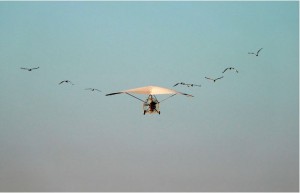
Adult mallard males use that imprint to identify adult mallard females as potential sexual partners. Male mallard chicks that were brought up by researchers using decoys of male mallards, try to mate with other males when they mature. Female mallards disregard the imprint of their mother when they look for a mate. Instead, they use innate preference to typical visual features of males. This is an example that an image that was learned at an early age to serve one purpose of the young serves a different purpose of the adult. It also illustrates that a cue that was learned early in life by both sexes is used later in life by males in different way than it is used (or not used) by females.
Claire
You have used the words learning and imprinting. What is the difference between the two?
Morie
In both cases, the brain keeps a record of a certain pattern of stimuli, be it visual, auditory, chemical or of any other kind. In imprinting, this can happen only within a limited time window. If the same stimuli happen before or after the critical period, they will not be recorded. A cow licks her newborn right after birth, to imprint in her brain its specific smell. That will enable her to recognize her offspring from all the other calves. If the calf is taken away from her at birth and returned after a few days, she will not be able to imprint its smell anymore.

Some people use the term imprinting to indicate an exact recording of an event. We will use it to indicate a recording that can take place only within a certain time window. Such a recording fills a missing part of an incomplete opp that cannot be used. After the missing part has been added, the completed opp becomes operational.
Bob
So, is ‘imprinting’ just another way of saying “an old dog cannot learn new tricks”?
Morie
Organisms are sometimes pre-wired to imprint information that would be crucial for their existence. OPPs are already hardwired in their system, except for arbitrary but relevant external information that needs to occur and to be imprinted. Once that information is imprinted, that opp is complete and it could be executed. For example, in the duckling’s brain, the entire opp is hardwired, except for the shape of whatever would be moving near-by after the hatching. When that information is collected and imprinted, the opp is complete and operational. The term ‘imprinting’ is usually used in that context.
Claire
Do humans imprint?
Morie
Yes. There are many things that humans can learn only within certain time windows, and once such a period is missed, they won’t be able to learn it anymore, or will learn it only to a lesser extent. For example, in order to learn a language, children have to be immersed in a language-speaking environment. Nowadays, many people move to countries where they have to switch to a second language. It was found that only children younger than approximately six years of age can learn to speak the second language without any noticeable accent. The vast majority of the adults cannot do it.
In a few traumatic cases, severely abused children grew up in almost complete social isolation. After their rescue years later, they could not regain normal language capacity.
Bob
Do we use the same mechanisms as the ducks for learning our sexual arousal and attraction cues?
Morie
The essence of imprinting is that there exists an incomplete opp in the brain, and that there are other innate learning mechanisms that the brain uses in order to complete it. The duckling can focus its eyes on a target, can walk to the target and stay next to it, but the target itself is not defined. Therefore, this incomplete opp is not yet functional. There is also an innate learning mechanism, whose role is to complete that activity plan. The learning mechanism is set to detect certain cues. The duck detects nearby objects that move. When those external cues occur, as mother duck moves nearby, the learning mechanism is triggered. Cues which are associated with the trigger, such as the shape of mother duck, are picked-up and fill the missing parts of the opp. That completes the opp and it becomes operational. From now on, the duckling would stay next to his mother, based on her visual cues.
Humans, too, have incomplete opps, whose missing parts are filled by imprinting. Some of those opps are used later in life for sexual attraction and arousal. So, in this respect, humans use the same mechanisms as ducks. The differences are in the cues that trigger the learning.
Bob
What is the content of the incomplete sexual opps in humans?
Morie
The circuitry of the incomplete sexual-attraction opp would set in motion the interest of the individual in a potential mate. For example, it will focus your eyes on the person that attracts you, and you will feel an urge to get closer and to touch that person. The opp would also notify other parts of the brain about the new situation, so that they could participate in planning your activities and prepare your body for them. What is missing and has to be learned are the cues that would identify the attraction target. That learned (imprinted) part would include cues about the features of the other person that would trigger the sexual attraction opp, e.g. physical characteristics of males or females in that particular society, and cues about their mental and physical disposition.
The circuitry of the incomplete sexual-arousal opp is already wired to set in motion the physiological aspects of sexual arousal that would cause, among other things, hormonal releases and the typical pleasant feeling experienced with the arousal. Some of that wiring is innate, and some develops automatically during childhood. The learned (imprinted) parts include the features of the other person, or what interactions with that person, would trigger the sexual arousal, e.g. flirtation, hugs, kisses.
While innate learning mechanisms fill-in the cues in the incomplete opps of sexual attraction and arousal, other innate physical mechanisms regulate the development of the sex organs. At puberty it all comes together; the mental opps have ready body parts that would carry out the sexual activities.
Bob
Could you please give an example that illustrates that point?
Morie
Consider an average baby boy that will grow and become a straight man. When he is born, his sexual system is immature. It consists of partially developed sex organs and an immature neural network that connects them to the brain. They all need further development and coordination in order to become functional at puberty. The boy has to first learn to identify women in his society. Then he has to learn to identify situations that call for his sexual arousal. Based on his non-sexual experiences, the genetic learning mechanisms identify women's features in his surroundings, and imprint them as cues into the sexual opps. These cues will help him to identify women in the society in which he grows up and to be aroused by them. At the same time, other genetic mechanisms develop the sex organs to their physical maturity. At puberty, the sexual-triggering-circuits complete their learning and the organs their maturation. The whole system becomes operational. The young man would be attracted by women, and his body would respond accordingly.
Becky
It seems that Mother Nature's strategy of having innate incomplete opps that are completed by individual experiences is not limited to sexual opps. It is used also for other critical life sustaining activities. For example, our feeding relies on both learned and innate opps. We learn to identify foods in our society by their looks. Once we identify food, eating and digesting it are coordinated by innate opps.
What is still unclear to me is what triggers new imprinting into the incomplete sexual opps in humans. In ducks, the imprinting is initially triggered by near-by movements of what should be mother duck. As all the ducklings grow up, they follow their mother who protects them and serves as a role model for internalizing various behaviors. Then, in mature males, it evolves into sexual attraction. In seagulls, feeding activities in the nest trigger the imprinting of cues that are used later for mate identification. What triggers the imprinting of cues into the sexual opps of humans?
Innate emotions and automatic imprinting of new sexual arousal cues
Morie
You hit the nail right on the head. Answering that question will give us the foundation for understanding how human sexuality evolves. We will first talk about the universality nature of the triggers of the learning, and then on the learned cues themselves.
Becky
What do you mean by universal triggers?
Morie
Universal triggers are triggers that have not changed throughout human history and that are the same for everyone. The same triggers have imprinted sexual attraction and arousal cues in humankind, always and everywhere.
While in ducks the imprinting is triggered by motion, sexual arousal imprinting in humans is triggered by emotion. The triggering emotion is a combination of two basic emotions: feeling safe and at the same time feeling threatened by another person. Associated features of events in which that emotion was felt by the child become basic core cues to sexual arousal. Additional cues are generalized sub-consciously from those core cues, and become cues for sexual arousal at puberty.
Bob
How are you going to prove that assertion? Can you probe the brain of children, let alone infants, and find out what they feel? And then, even if you could, how will you pin those thoughts on grown-ups that are engaged in sexual activities?
Morie
Humans are part of nature. We'll see that Mother Nature had good reasons to design us that way. Other animals also show signs of those feeling in their mating season. We'll see that infants and adults have the capability to experience that feeling. When children are experiencing it, they become very attentive and learn the situation. When grown-ups are experiencing that feeling, they get excited. We'll see that when certain groups of humans that are engaged in sexual activities express their feelings, there is no doubt that that is what they feel.
Let's start with emotions. Sexual attraction and arousal are emotions, therefore it should not come as a surprise that innate emotions trigger the imprinting of their associated cues. The basic emotions of humans are innate and universal; they are hardwired in every one of us. They include joy, sadness, satisfaction, fear, disgust, surprise and some more. They have their typical universal facial expressions.

Newborns have hardwired reflexes and facial gestures that express those emotions in a universal way. Those reflexes and facial expressions do not depend on sex, race, ethnicity, geographical location, and they have not changed throughout history. All babies will make the same universal grimace of disgust when they taste for the first time new food that they do not like. The neural circuitries that control these behaviors are innately hardwired in us. They are “nature”. They take part in a variety of brain operations and behaviors.

When certain fundamental emotions are stirred in the child, associated feature of that event become cues that are imprinted into the incomplete innate sexual opps. Those imprinted cues determine what would sexually attract and arouse that person later in life. The fundamental emotions that trigger the imprinting are universal; all humans possess them. The imprinted information, though, is individualistic; it depends on the personal experiences associated with those emotions.
Claire
So, how would we identify those emotions?
Morie
Those emotions have to be typical to situations when sexual arousal has to be activated. Sexual behavior is about certain specific interactions with another person. The beginning of such interactions, especially at puberty, may be characterized as guarded attractions: Approach a potential mate, or allow a potential mate to approach you, but be on the alert. After all, a stranger is going to enter your space. When you start to also feel safe, the innate parts of the sexual opps, which coordinate the activities of the sex organs, kick in. When the combined emotion of feeling safe and feeling threatened by another person is invoked in a child (in non-sexual circumstances), associated stimuli are imprinted in the child's brain. Those associations and their associations become later-on cues that trigger sexual arousal. Such cues may be a body part of the other person, a response of the child to the situation, and so on.
Claire
Could you please give an example?
Morie
Many common sexual-arousal-triggers have nothing to do with physical stimulation of sex organs. The arousal is a pure mental process. For example, some people are aroused by looking at the legs of a potential partner. During the childhood of those individuals, legs have become a cue of sexual arousal. This may have happened like that: Children are found quite often near the legs of their caregivers. They feel safe there, and when some threat arises, they feel a combination of safety and a fear. The legs, which are associated with that new feeling, are imprinted into an incomplete opp by an innate subconscious learning mechanism. At puberty, the sight of legs will act as a cue of that opp, and trigger sexual arousal. (In similar ways, other body parts and inanimate objects may become sexual arousal cues.)

Expansion of imprinted cues is a general process that the brain employs. For example, babies feel safe when they have the attention of their mother. They first may realize that they get attention by crying. The crying is then expanded to include many other behaviors that get attention such as: mischievous behavior, behaving nice as expected, explicitly demanding attention, or pretending not to care about getting attention. Depending on the individual, those behaviors and their generalizations may be applied towards other people in order to feel safe with them, and/ or to be sexually aroused by them.
Claire
At what age can children feel the sequence of those emotions towards strangers, and internalize their learned responses?
Morie
At around six month of age, babies normally become attached to their mothers (or to their main caregiver). While up to this age they would smile at any person, at this juncture they reserve their genuine smiles only to people that are close to them. When approached by strangers, they would cling to their mothers for safety. Usually, it is not hard to tell that they also enjoy, or at least are fascinated, by watching the stranger from the safety of their mother. The babies then become aware of their own fear of strangers and realize that they can do things to abate it and feel safe again. They develop, test, and implement emotional strategies for interaction with other people; from blind trust to indifference to animosity and the need to dominate the other. Those acquired behavior modes could serve as an important component in general social interactions, as well as in sexual arousal opps.

Claire
How strong is that fear of strangers?
Morie
It varies in its intensity and in its duration. It is rarely very intense, or terrifying. It can be described as feeling intimidated by the presence of larger humans, and playing it safe. Often, it subsides a few minutes after evaluating the new situation. However, in some cases it evolves to complete avoidance of adults for prolonged periods of time.
With time, the baby realizes that his mother, too, is sometimes a source of tension, especially when she responds to his own activities. There are activities that she approves of, and activities that she disapproves. The baby likes her attitude towards him when she approves his activity, and dislikes it when rebuked. He learns that doing what she likes results in his gratification. This concept is then generalized in the baby’s mind by replacing his mother with a generally significant person. Seeking satisfaction by doing something that pleases another person becomes a central concept in his mind, and it affects his activities throughout his life. It also becomes a component in sexual arousal.
To his mother’s dismay, quite often the baby finds out that he can avoid her antagonism and the negative feelings that follow, by controlling her. If he adopts certain assertive or offensive stances towards her, she will tolerate activities of his that she does not like. This is generalized to the concept that controlling other people makes him safe. It becomes an important notion throughout his life, including in his sexual arousal. Controlling other people and satisfying their wishes are two sides of the same coin, which buys the feeling of safety with them.
The brain processes information in parallel, and it can handle several emotions at the same time. For example, a baby may feel intimidated by a stranger, and at the same time feel safe as he clings to his mother. The perceived threat is hovering above him together with the security that he feels with his mother. This superposition of conflicting universal emotions may serve later as an ingredient in sexual arousal.
Bob
You have mentioned that in gulls, feeding activates the imprinting of associated visual patterns that happen to be found within the chick’s field of view. Those visual patterns serve later-on as cues in mate identification. Similarly, does breast-feeding in humans cause the imprinting of cues, which serve later on as triggers of sexual attraction and arousal?
Morie
I doubt it for two reasons. First, nowadays, large numbers of babies are bottle-fed by male and female caregivers. If feeding activities were serving as imprinting triggers for associated features that the nursing baby sees, large numbers of adults would be sexually attracted and aroused by feeding bottles, or by someone that holds such a bottle. I am not aware of that. Second, the visual patterns of mature gulls are universal and do not change with time. Therefore, patterns that are imprinted by the chicks remain valid as the chicks mature. This is not the case for humans. At least in Western civilizations, visual cues that can be extracted from early caregivers are usually different from cues that would be available later in life from potential sexual partners. Just consider how fashion and gender appearances vary with location and change so frequently in one’s lifetime.
Feeding activities in humans serve as triggers of learning the concept of ‘another human-being like me’ (‘person’). This concept starts to crystallize around cues that originate from the caregiver, such as the facial features of the mother, features of her voice, footsteps, smell, softness, and so on. The concept ‘person’ is then expanded through more experiences. It sprouts many other related concepts such as child, grown-up, mother, father, etc. Those concepts take part in other concepts including cues in sexual opps. So, I believe that breast feeding in humans, and feeding in general, help to form and shape the concept of person, which is central to all social and sexual interactions. As the child grows up, breasts and chests become sexual cues due to their association with situations that make the child feel safer in the presence of threats. In addition, breasts become a sexual arousal cue after the core sexual orientation of the individual has crystallized, and more cues that identify a woman are added to the arousal repertoire. Depending on individual experiences, that may happen before or after puberty.
Development of new concepts from old ones
Claire
I understand that new concepts evolve from existing ones. What are the mechanisms that regulate this process?
Morie
How the brain organizes its concepts is a topic by itself, and it is a main subject of micropsychology. Click here to read more about it. I’ll just say a few words about it now. Generalization is a main process that the brain uses for creating new concepts from existing ones. Here are some examples about sexual arousal concepts.
At an early age, a child develops the concept ‘in order to feel safe with mother, I have to please her’. This is an established root concept, from which other concepts sprout. A generalization of this concept could be ‘in order to feel safe with a person, I have to please that person'. Based on testing it in real life situations, the concept may be further refined to: ‘in order to feel safe with a significant person, I have to please that person'.
The last concept and some of the concepts that sprout from it are crucial to the social development, to sexual function, and to the self-esteem of the individual. When combined with other sexual cues, it serves as a trigger sexual activities and to the sensation of sexual gratification. It creates that sensation in those who are aroused by pleasing their partner.
With time, the repertoire of activities for pleasing a sexual partner expands. The specifics of those activities depend on the environment in which the individual has been raised. Those activities fall into two major categories. One category includes activities that create positive emotions in the sexual partner, such as joy, relaxation, curiosity and safety. Another major category is activities that eliminate negative emotions, such as apprehension, that the partners might feel towards each other. We will see that feeling safe with another person is the common denominator of many sexual arousers.
Claire
Why do you suggest that learning sexual cues evolves over time from non-sexual experiences?
Morie
For two reasons. First, look around you. Part of our sexual attraction depends on non-sexual cues such as eye color, hair color, skin color, smile, height, weight, length of legs, temperament, clothing items and so on. Those simple cues can be learned, at least at the beginning, before concepts about gender have been acquired by the child.
Second, learning is a progressive process. It starts by learning general concepts, which are then refined, partitioned and elaborated. ‘People’ is one of the first concepts that the baby will learn. Then, she will become attracted to some people more than to others. The cues to the attractive people will be classified in her mind according to the kind of emotion with which they are associated. Only then, cues that relate to gender, which is a concept that crystallizes later in her mind, would be added to the mix.
States-of-mind and hormones
Morie
Most animals are sexually active only during certain time windows. Humans, on the other hand, can engage in sex year round. However, it appears that both humans and animals have two distinct states-of-mind: sexual and non-sexual. All animals relate to the world around them according to their prevailing state-of-mind: When in their sexual state-of-mind, solitary animals seek the company of mates, and foraging animals ignore food when they are in sexual state-of-mind. Human perceptions of the world and of their internal feelings depend too on whether sex is involved or not.
In animals, the transition from one of those states-of-mind to the other is regulated by hormones. Hormonal levels, in turn, may be influenced by external conditions such as weather or food availability. In humans, hormones affect the overall level of the libido. In addition, neural processes, conscious and sub-conscious, determine if a situation is treated sexually or non-sexually.
OPPs control the behavior of an individual in response to ongoing external conditions. Sexual opps may result in behaviors different from those guided by non-sexual opps, even if they are responses to the same prevailing conditions. The state-of-mind in which an organism is found determines which opps would actually be carried out.
INNATE EMOTIONS AND SEXUAL AROUSAL
Feeling Safe And Threatened With Another Person (SAT-WAP)
Bob
We have seen that cues that contribute to sexual arousal and to the identification of sexual mates evolve during childhood from non-sexual, emotional experiences. Those emotions are combinations of feeling safe with another person while feeling somewhat threatened. The learned cues are imprinted into innate, incomplete opps, and become fixated. They determine what would sexually-arouse that person later in life.
Morie
Well said.
Bob
If feeling safe with another person in the presence of some threat is a central element in sexual arousal, why not give it its own name? We could use the acronym feeling SAT-WAP, for feeling Safe And Threatened With A Partner for the adult. It could stand also for feeling Safe And Threatened With Another Person for the child.
Morie
Good idea. Let’s do it. So, feeling SAT-WAP in a child may trigger the imprinting of sexual cues. Feeling SAT-WAP in an adult is a component of the trigger of sexual arousal.
Becky
So, feeling SAT-WAP has a dual role: (1) feeling SAT-WAP triggers the imprinting of new cues into the arousal opp, and (2) feeling SAT-WAP triggers arousal. That reminds me of conditioning and Pavlov's experiments. In Pavlov’s famous experiment, a bell sounded when food was given to a dog. After several repetitions, the dog salivated to the sound of the bell, even if food was not given. Sensing the food caused two things: salivation, and expanding the repertoire of stimuli that cause salivation (to include also the bell’s sound). Feeling SAT-WAP is the analog of sensing the food. Feeling SAT-WAP causes two things: expanding the repertoire of things that cause sexual arousal, and becoming aroused.
Morie
Right.
Sexual SAT-WAP and social SAT-WAP
Claire
Why we do not become sexually aroused when we are children and we feel SAT-WAP?
Morie
Because the rest of the sexual system is not physically mature yet.
Claire
If so, why we do not always become sexually aroused, as adults, when we do something that pleases another significant person and we feel SAT-WAP?
Morie
Feeling SAT-WAP is a necessary condition for achieving sexual arousal at puberty, but it is not a sufficient condition. Without feeling SAT-WAP there is no arousal, but SAT-WAP by itself is not enough. The aroused person has to be in a sexual state-of-mind, and the external conditions have to be conducive to arousal. Also, the sex of the target person has to match the sexual orientation of the aroused one.
The brain has two groups of opps for feeling SAT-WAP. One group is used in social context and the other in sexual context. The goal of the social opps is to enable social interactions between individuals. When performing those opps, the individuals feel safe in their social environment, and that facilitates their inter-personal interactions.
The goal of the sexual opps is to evoke sexual arousal in the individuals, thus enabling them to engage in sexual activities.
Some activities, such as giving presents, create SAT-WAP feelings in both social and sexual contexts. However, as we will see later, some activities create beneficial SAT-WAP feelings in the sexual context and negative feelings in the social context and vice versa.
Courtship and sexual arousal in other species
Let’s look now at examples from animals, and see if we can find in them human-like emotions that are expressed in their sexual behavior.
The sexual process in many species includes a period of courtship. After a prospective mate has been identified, the partners forge a bond and arouse each other in courtship that, if successful, leads to mating. Courtships may be simple or elaborate. Some species exhibit behaviors with striking similarities to humans, while others are a class of their own. Let's look closer at some of the similar ones.
In many species, courtship intertwines gestures of greeting and aggression. To a human observer it appears that the partners are involved in an enjoyable game of controlled aggression and friendly closeness. They exchange playful gestures of fear, aggressiveness, relaxation, dominance and submission, borrowed from earlier periods of their lives, when they were fed and groomed by their parents and socialized with their siblings and peers.
Adult male grizzly bears lead solitary life most of the year, avoiding females and being avoided by them. They start their two months mating season with a search for a female. Once he comes across a female’s track, the suitor will follow it, sniffing her day-beds and urine traces. She will run away from him and he will follow her, keeping his distance. If he gets too close too soon, while she is still afraid of him, she will charge at him aggressively and may smack him with her paw. The bigger and powerful male will retreat and comply. After a while, she gets used to the menace, and allows him to get closer. After they have made contact, they will nuzzle and chew on each other’s head and neck and enjoy friendly wrestling bouts, like little cubs. There have been reports of males caressing and fondling females. After copulation, they go their own separate ways.
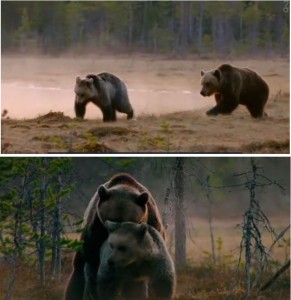
The female in a few primates is the one who courts the male. When she is ready, she raises her tail and presents her hindquarters to the male. She looks at him backwards in a subordinate posture, making sounds that are a combination of cooing and fear. If he is aroused, he will clasp her ankles firmly with his feet, grab her buttocks with his hands, and copulate.
Bull elephants start their courtship by following a ready female. She may try to escape and he would follow her persistently. If she accepts, they will stroke each other with their trunks, intertwine them, and place their tips in each other’s mouth, expressing mutual confidence and care.
Those examples illustrate how some species use the message: “you should not be afraid of me” to form bonds and to arouse sexual partners. Other species use the emotions of fear and safety in a different way. A male will direct his aggressive behavior towards other males, chasing them away from his only sweetheart, as in the case of Canada geese, or chasing them away from a whole harem, as in the cases of elephant seals, zebras, deer, lions, and others. The implied message to the females in these cases might be “I am the strongest. With me you are safe”. If that is not enough, explicit threats and direct attacks on straying females are initiated by the male, as in the case of fur seals.
Claire
Is feeling SAT-WAP the only emotion that triggers sexual arousal in animals?
Morie
It is hard to tell precisely what emotions are experienced by animals during their courtships. It would be prudent to suggest that emotions other than fear and safety are aroused in many species. Some water birds have amazing courtship dances that might create sheer enjoyment in their mates. Similar effects may be achieved by stunning appearances, like those of the peacock or the greater bird of paradise. Nightingales and other songbirds use peaceful and enjoyable songs to build interest and arousal in their partners. The fundamental emotions behind those experiences could be the enjoyment of novelty and the diversion from the mundane. Some species, such as the crested fern, offer fish or other foods to their wooed. Here the fundamental emotion of pleasing through feeding is certainly in action. And the list goes on. One thing is clear: fundamental emotions, which play a role also in non-sexual experiences, take part in the sexual process, especially in mate identification and in arousal.
The emotional components of human sexual arousal
Mental processes in BDSM
Morie
Let us now focus on the second body of evidence, which supports the assertion that sexual cues in humans are built around fundamental emotions, which are first experienced during childhood in a non-sexual context. Paramount are the combined emotions of feeling safe while fear is in the background (feeling SAT-WAP). In order to have sexual connotations, the feeling of safety and/or the feeling of being threatened need to be caused by another person.
Many couples enjoy role acting that arouses them sexually. Each partner plays a role that appears to be non-sexual, but the basic emotions created by the play trigger sexual arousal. The general scheme of such plays is the interaction between two individuals, one dominant and the other submissive. In some cases, those plays are very subtle, and in others they are obvious and unmistakable. The latter are referred to as sadomasochism (SM), bondage and discipline (BD), discipline and submission (DS), and overall as BDSM. The players are referred to as dom and sub or top and bottom. Both players identify with their roles and play them willingly and full heartedly. Common characters in such plays include a nurse and a patient, a guard and a prisoner, a teacher and a student, a master and a slave, a trainer and a dog, a parent and a child, a goddess and a worshiper, a human and a footstool, and more. The overall emotion of the top in all those plays can be characterized as feeling safe with a controlled partner, whose potential threat is subdued. The overall emotion of the bottom is feeling safe by pleasing a significant person, who is a potential threat. The two interpersonal emotions of feeling safe and of feeling threatened by another person are present in humans since infancy. Behavior patterns towards other people in society in general, in the family, and in sexual relationships are built from a core consisting of those two emotions.
The fact that any of the roles can be played by a male or by a female may be an indication that sexual arousal in women and in men is driven by the same core emotions. Children can feel those emotions in non-sexual experiences, and extract from them cues that after puberty trigger sexual arousal.

Claire
Are physical pain and humiliation involved in those plays?
Bob
It is up to the participants to choose how dominance and submission are expressed. They may choose benign symbols and gestures to express and arouse their emotions, but they may also choose harsh means. It depends on the participants. If both enjoy and want it, physical and mental pains are involved. If it is not done between adults with total free consent and desire of all parties, it is not considered sexual play; it may be a crime.
Claire
It may be a crime or it is a crime?
Bob
The way things are, it is not always a crime. In the workplace, a boss may humiliate a subordinate, who does not want to be treated like that. The subordinate accepts it for pragmatic reasons, but definitely does not derive any pleasure from it. The humiliation and suffering of the subordinate may arouse the boss sexually. If the humiliation is tied only to work performance, and no external signs of the boss’s sexual arousal are indicated, it would not be considered a crime.
Claire
Is BDSM a mental disease?
Bob
It is a controversial issue. According to the Diagnostic and Statistical Manual of Mental Disorders (DSM-5), the main diagnostic reference in the USA, to be considered a clinical disorder, these fantasies, urges, or behaviors must occur for a significant period of time and must interfere with either satisfactory sexual relations or everyday functioning. There is also a sense of distress within these individuals. The International Classification of Diseases (ICD-10), which is adopted by the World Health Organization, classified such behavior-patterns as disorders of clinical significance. However in the draft version of ICD-11, the tendency is to move towards the DSM-5's stance.
Sol
Why use those behaviors as examples for making our point?
Morie
Because in those cases we do not rely on what people choose to tell us about their emotions and thoughts. We draw conclusions from observations on activities that are being practiced by millions of people. Our premise is that certain non-sexual emotional experiences in early life, especially those related to SAT-WAP, provide the cues that later play a part in sexual arousal, healthy or not. We can directly observe those cues in action. Moreover, there is a strong body of evidence that people who are not engaged in that kind of role-playing still use those same motifs in their sexual fantasies. They have the same thoughts, but they do not carry them out. They arouse themselves, as sole practitioners or as partners, using those same cues.
Claire
Why do some people resent those sexual-role-plays?
Bob
As members of society, individuals have to know how to engage with their peers, their superiors and their inferiors. Those who violate the rules of engagement pause a risk to themselves and to others. In sexual-role-playing, players may fill roles that are inconsistent with their real social status, or do things that they would not do in real-life situations. For example, people high on the social ladder may play the most humiliating roles, or gentle souls may play the role of brutal slave drivers.
People who resent those sexual-role-plays believe, in one way or another, that there is a strong link between the sexual-plays and real life. Like moviegoers who do not separate the real from the screen personality of a movie star, some resent people because of their roles in sexual-plays. They rail against others and would hate to find such traits in themselves. Some may have concerns, which are sometimes founded, that the role-playing may overflow, and interfere with real-life activities.
Claire
It seems that in SM, the pleasure comes from enjoyment of inflicting physical and emotional pains, or from suffering pain and humiliation, and not from feeling SAT-WAP.
Morie
SM relies on two inter-personal relationships: controlling a submissive and pleasing a dominant. The observable physical expressions of inflicting pain and humiliation and suffering them have underlying mental processes. A dom may experience several opposing emotions such as: I am safe through controlling the sub by inflicting pain and humiliation. Or: I am good because the sub is enjoying the pain and the humiliation that I bestow. Or I am mean because I enjoy being cruel. The sub, too, may experience several opposing emotions: I am safe with the dom, the dom appreciates my pain and humiliation. Or I enjoy being hurt, and it is bad to be hurting. The brains of the players add up their emotions, and the totals turn out to be enjoyment. Had the total in any player been unfavorable, that player would not engage in that activity.
Sol
The claim is that the combination of the opposite emotions: feeling safe and feeling unsafe causes sexual arousal. Are there non-sexual situations in which feeling a combination of opposite emotions at the same time causes arousal?
Morie
People who ride a roller-coaster are excited about their ongoing situation. Their overall emotion is a combination of feeling scared, and at the same time feeling safe in the confines of the roller-coaster cart and its safety belts. This is one of many examples of being aroused by a combination of two opposite emotions.
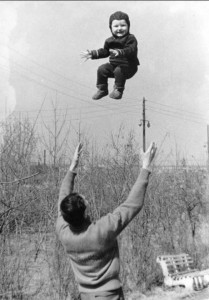



Intimacy and SAT-WAP
Claire
Do romantic feelings have any role in sexual arousal?
Morie
SAT-WAP is not the only emotion that plays a role in sexual arousal, but it is a major one and its fingerprints may be found in many situations that involve other emotions. It is quite common that when several emotions are at play, feeling SAT-WAP is the one that most probably triggers the arousal. Here are some examples.
The natural tendency of humans and many animals to be intimate while engaging in sex might be another indication to that. Intimacy is characterized by retreating from the rest of the world, physically or mentally. The partners are seeking to be shielded from outside interference, and the unwanted or unsafe consequences that may follow.
In addition to seeking a shielding from the outside, the partners are engaged in a variety of activities that strengthen their feeling SAT-WAP. Activities that build trust, such as exchanging personal histories and secrets, are one example. Sharing a secret with someone is entrusting that person with a power to harm you. It is a way of saying indirectly: you should not be afraid of me because you have power over me. I am entrusting you with that power. On the other end, keeping another person’s secrets is a way of saying: with me, you are safe; I am protecting your interests. I appreciate your trust in me.
Another example is activities that build up good mood. Sense-of-humor is very high on the list of the desired qualities in a partner. Generosity is another. Having a common interest is also at the top of the list. The good mood that is created by those activities drives away feelings of apprehension that a partner might have, thus increasing the feeling of safety.
Arousal fantasies in children and adults
Becky
One of the strategies that the brain uses to learn how to function in the environment is based on rewards and consequences. It strengthens behaviors that result in positive feelings and weakens behaviors that result in negative feelings. For example, we learn to eat tasty foods and avoid bland ones. We learn to look for shade when the sun is scorching, to open a window when the air is stuffy, and so on. You have pointed out that sexual pleasures could be guiding us in learning behaviors that satisfy us sexually. However, those pleasures are felt after puberty. Is there any sexual-like pleasure before puberty that can guide learning of sexual cues?
Morie
I believe that there is such a pleasure even before puberty, but that emotion is not fully formed. It is a precursor, which evolves to the feeling of sexual pleasure at puberty. The circuitries of sexual feelings and sensations together with the sex organs are all parts of one evolving system. They are all present from early on in an immature form, and they all mature at puberty.
A child enjoys fantasizing about a variety of subjects. It is fascinating to observe the enjoyment that children show as they use their imagination while playing with toys. Children fantasize about roaring cars and crying dolls. They are thrilled to hear scary stories and to empathize with the characters. In their fantasies, children weave their emotions with thoughts about real world situations. Children build their emotional infrastructure as they grow up. There is no apparent reason why a child could not be able to fantasize about feeling safe in the presence of an intimidating person, and enjoy those thoughts. That enjoyment is achieved through circuitry that delivers some kind of a positive feeling. Before puberty, that positive feeling cannot be associated with full-scale sexual activity, because such activity is non-existent. It is associated mainly with thoughts. After puberty, that circuitry triggers the emotion of sexual pleasure. At that stage, the emotion can be associated with mature sexual activities of the body.
By thinking about sex, adults develop their perceptions about it. In their thoughts, they construct general scenarios in which they would like to be, and make programs for what they would do. The feedback provided by the sexual pleasure circuitry guides them in devising those programs. Later, they may carry out the programs. Similarly, the pre-puberty sexual pleasure circuitry must be guiding children in the development of their initial sexual pleasure programs. They develop all kinds of programs for what to do, in order to feel SAT-WAP, and enjoy it. After puberty, those programs are incorporated with concrete sexual activities.
SAT-WAP and physical stimulation
Becky
We have limited our discussions to mental arousal. We have intentionally excluded physical activities, such as caressing, kissing, patting, and so on from our discussions. Are such activities purely physical, or do they have a mental dimension too?
Morie
They definitely have a mental dimension. Kissing, hugging, caressing, and in general touching involve invasion into the partner’s domain. The actions themselves are considered tokens of friendship that the active partner conveys and the passive partner accepts and reciprocates. The partners are expressing with those actions their SAT-WAP feelings towards each other.
Becky
And what about intercourse positions; do they carry SAT-WAP messages as well?
Morie
A variety of intercourse positions have been used and enjoyed since early times, and are described in many classical texts such as the Kama Sutra and in modern literature. Some positions may be more efficient in eliciting stronger physiological stimuli than others, depending on the anatomical makeup and the agility of the partners. However, one cannot ignore the implied messages that the extra planning and coordination of some of the stylish positions send: What I am doing is going to increase the pleasure of my partner; my partner is trying to increase my pleasure. Therefore, I feel SAT-WAP with my partner, my partner feels SAT-WAP with me.
Bob
Talking about positions, isn’t it interesting that Mother Nature has provided many species with only one intercourse position; male above female? Is Mother Nature implying that males are dominant?
Morie
It is not only top and bottom; it is also front and back. In many species, the male mounts the female from her hind side. The hind side is more vulnerable than the front, where the teeth are. If you want to interpret the body language of the animals, you might say that the female is saying: I am exposing to you my vulnerable, non-combative side. I feel SAT-WAP with you. The male from his perspective also feels SAT-WAP because of that. To me, Mother Nature’s use of SAT-WAP as the trigger of sexual arousal is intended to base the entire process on cooperation between the sexes, rather than on coercion.
Bob
Let’s look at the so called “missionary position” (man on top, woman underneath while facing each other). Don’t you think that this configuration symbolizes dominance of men and submissiveness of women?
Claire
Let me ask you a question. In society, there are people who work hard and people who relax and enjoy the hard work of others. Who is the dominant; the servant who works hard, or the queen who relaxes and reaps the benefits of the servant’s work?
Bob
The queen, of course.
Claire
And in the missionary position; who lies back, and who is huffing and puffing and working his tail off?
Bob
Touche.
Claire
It's mind over matter.
Morie
It is getting late, my friends. In our next meeting we will focus on the first phase of sexual interaction; sexual attraction. In the meantime, if you want to read a little bit about it, click here. See you then.